EC4F05 - Business Environment: Tesco and Stakeholder Analysis
VerifiedAdded on 2023/01/13
|8
|1921
|39
Report
AI Summary
This report provides an in-depth analysis of the business environment, focusing on Tesco as a case study. It begins by differentiating between public (NHS), private (Tesco), and voluntary (Oxfam) organizations, outlining their purposes, legal structures, and key stakeholders. The report then delves into the crucial role of stakeholder management for organizational success, specifically examining the influence of shareholders, employees, customers, suppliers, the government, and society on Tesco. Furthermore, the report explores the impact of local, national, and international environments on businesses, using examples like local barbers, Doughnut Time, and Tesco. The report concludes by assessing the impact of fiscal and monetary policies on Tesco's operations. Finally, the report offers a comprehensive overview of the interplay between these factors and Tesco's strategic approach, providing a valuable resource for understanding business operations in a dynamic context.
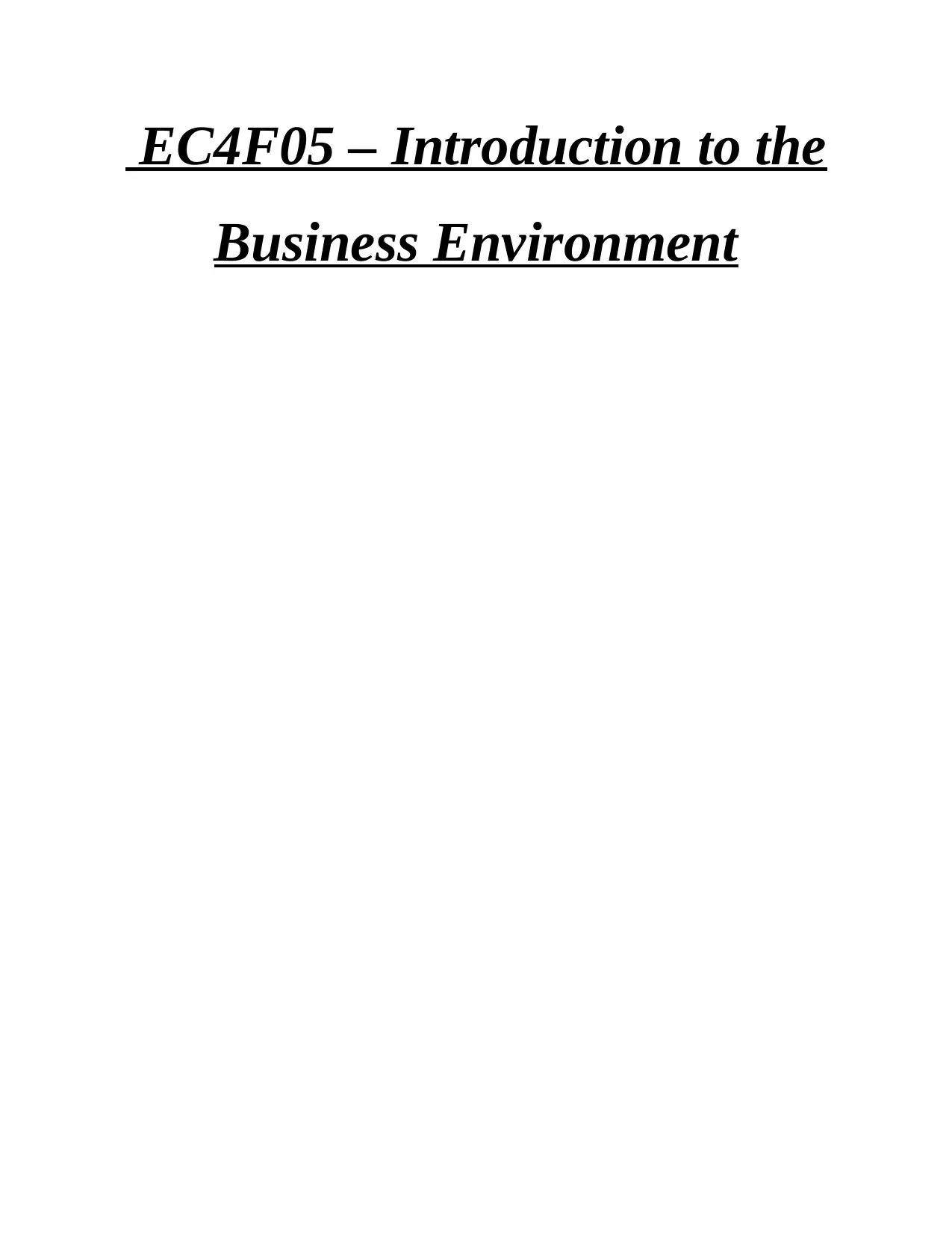
EC4F05 – Introduction to the
Business Environment
Business Environment
Paraphrase This Document
Need a fresh take? Get an instant paraphrase of this document with our AI Paraphraser
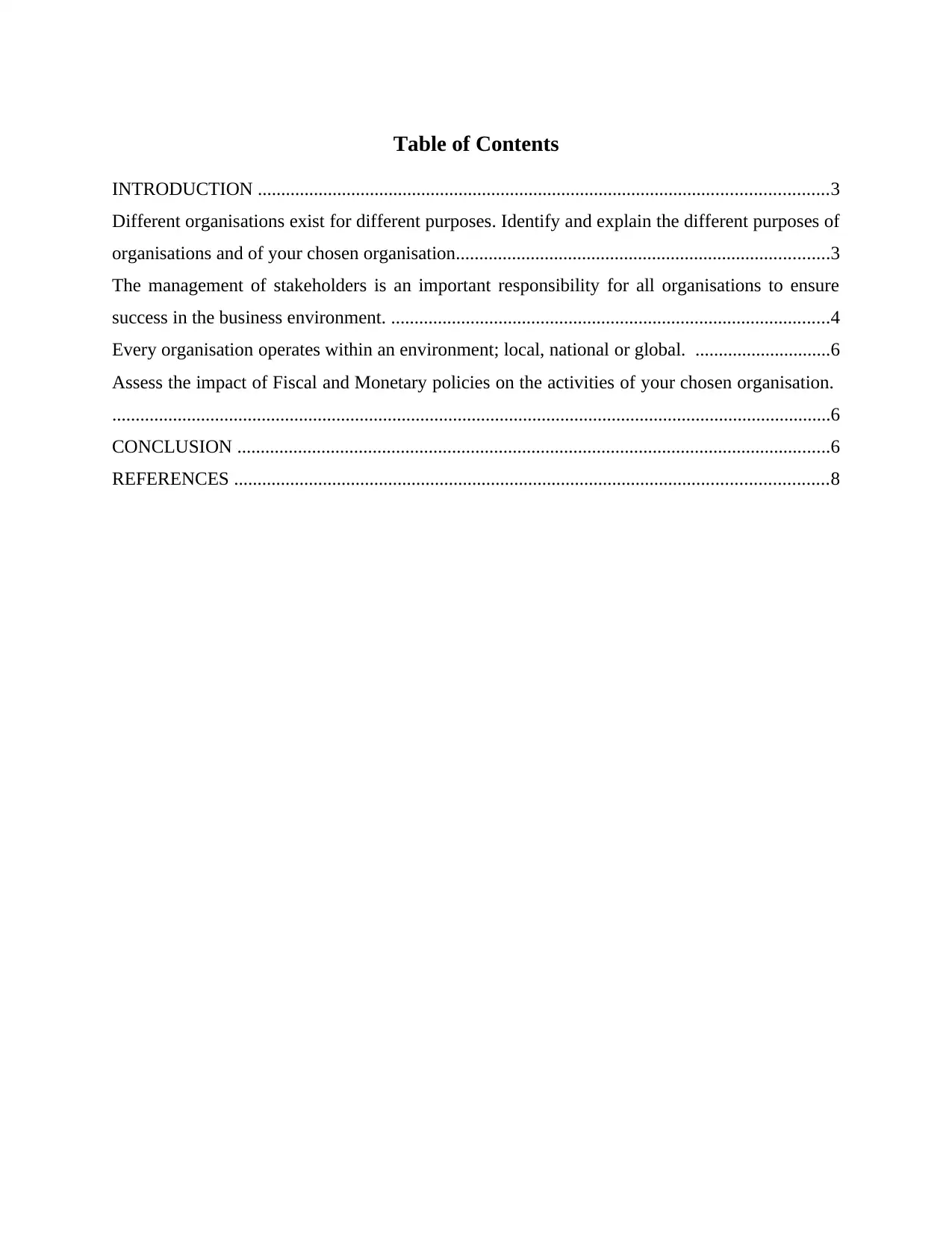
Table of Contents
INTRODUCTION ..........................................................................................................................3
Different organisations exist for different purposes. Identify and explain the different purposes of
organisations and of your chosen organisation................................................................................3
The management of stakeholders is an important responsibility for all organisations to ensure
success in the business environment. ..............................................................................................4
Every organisation operates within an environment; local, national or global. .............................6
Assess the impact of Fiscal and Monetary policies on the activities of your chosen organisation.
..........................................................................................................................................................6
CONCLUSION ...............................................................................................................................6
REFERENCES ...............................................................................................................................8
INTRODUCTION ..........................................................................................................................3
Different organisations exist for different purposes. Identify and explain the different purposes of
organisations and of your chosen organisation................................................................................3
The management of stakeholders is an important responsibility for all organisations to ensure
success in the business environment. ..............................................................................................4
Every organisation operates within an environment; local, national or global. .............................6
Assess the impact of Fiscal and Monetary policies on the activities of your chosen organisation.
..........................................................................................................................................................6
CONCLUSION ...............................................................................................................................6
REFERENCES ...............................................................................................................................8
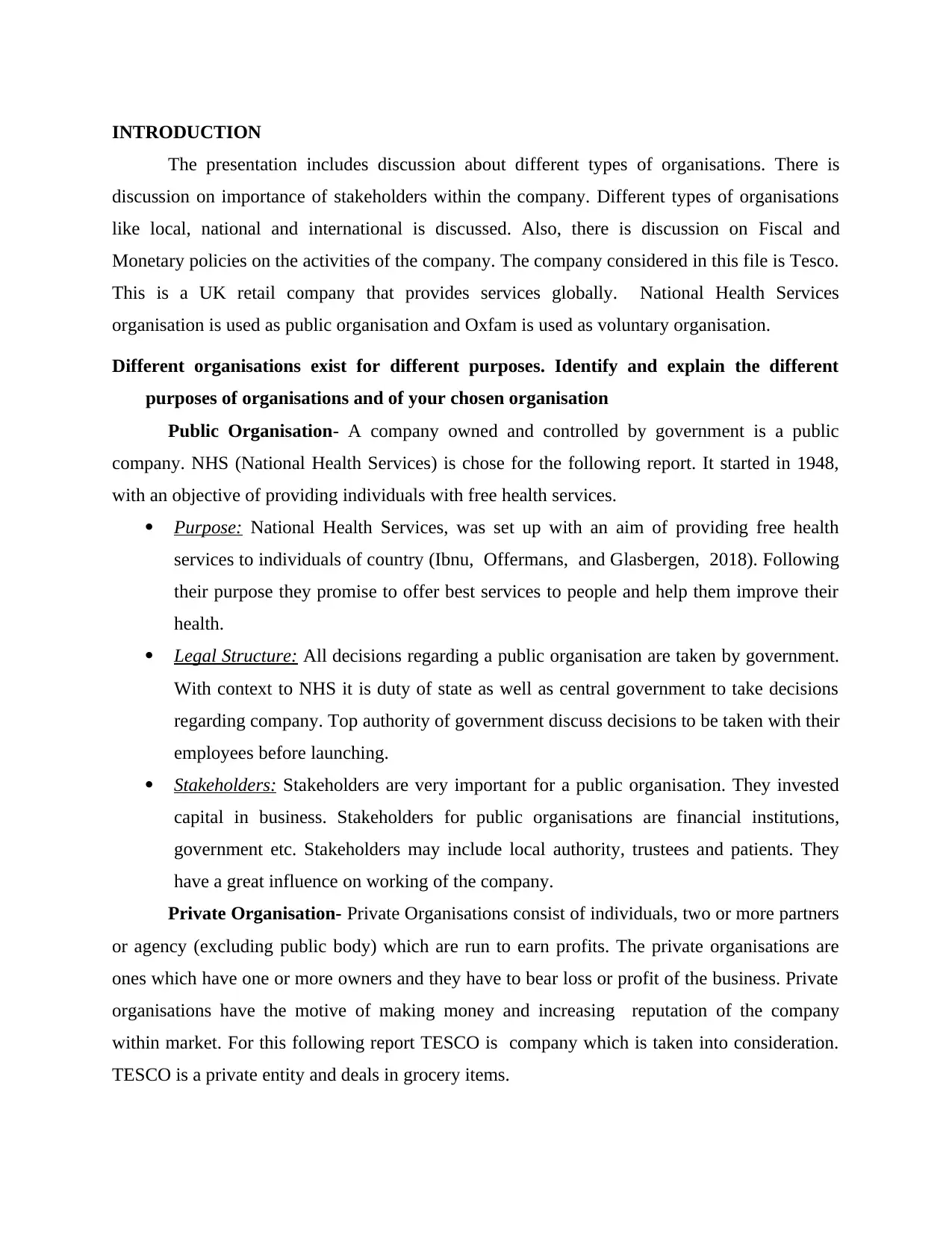
INTRODUCTION
The presentation includes discussion about different types of organisations. There is
discussion on importance of stakeholders within the company. Different types of organisations
like local, national and international is discussed. Also, there is discussion on Fiscal and
Monetary policies on the activities of the company. The company considered in this file is Tesco.
This is a UK retail company that provides services globally. National Health Services
organisation is used as public organisation and Oxfam is used as voluntary organisation.
Different organisations exist for different purposes. Identify and explain the different
purposes of organisations and of your chosen organisation
Public Organisation- A company owned and controlled by government is a public
company. NHS (National Health Services) is chose for the following report. It started in 1948,
with an objective of providing individuals with free health services.
Purpose: National Health Services, was set up with an aim of providing free health
services to individuals of country (Ibnu, Offermans, and Glasbergen, 2018). Following
their purpose they promise to offer best services to people and help them improve their
health.
Legal Structure: All decisions regarding a public organisation are taken by government.
With context to NHS it is duty of state as well as central government to take decisions
regarding company. Top authority of government discuss decisions to be taken with their
employees before launching.
Stakeholders: Stakeholders are very important for a public organisation. They invested
capital in business. Stakeholders for public organisations are financial institutions,
government etc. Stakeholders may include local authority, trustees and patients. They
have a great influence on working of the company.
Private Organisation- Private Organisations consist of individuals, two or more partners
or agency (excluding public body) which are run to earn profits. The private organisations are
ones which have one or more owners and they have to bear loss or profit of the business. Private
organisations have the motive of making money and increasing reputation of the company
within market. For this following report TESCO is company which is taken into consideration.
TESCO is a private entity and deals in grocery items.
The presentation includes discussion about different types of organisations. There is
discussion on importance of stakeholders within the company. Different types of organisations
like local, national and international is discussed. Also, there is discussion on Fiscal and
Monetary policies on the activities of the company. The company considered in this file is Tesco.
This is a UK retail company that provides services globally. National Health Services
organisation is used as public organisation and Oxfam is used as voluntary organisation.
Different organisations exist for different purposes. Identify and explain the different
purposes of organisations and of your chosen organisation
Public Organisation- A company owned and controlled by government is a public
company. NHS (National Health Services) is chose for the following report. It started in 1948,
with an objective of providing individuals with free health services.
Purpose: National Health Services, was set up with an aim of providing free health
services to individuals of country (Ibnu, Offermans, and Glasbergen, 2018). Following
their purpose they promise to offer best services to people and help them improve their
health.
Legal Structure: All decisions regarding a public organisation are taken by government.
With context to NHS it is duty of state as well as central government to take decisions
regarding company. Top authority of government discuss decisions to be taken with their
employees before launching.
Stakeholders: Stakeholders are very important for a public organisation. They invested
capital in business. Stakeholders for public organisations are financial institutions,
government etc. Stakeholders may include local authority, trustees and patients. They
have a great influence on working of the company.
Private Organisation- Private Organisations consist of individuals, two or more partners
or agency (excluding public body) which are run to earn profits. The private organisations are
ones which have one or more owners and they have to bear loss or profit of the business. Private
organisations have the motive of making money and increasing reputation of the company
within market. For this following report TESCO is company which is taken into consideration.
TESCO is a private entity and deals in grocery items.
⊘ This is a preview!⊘
Do you want full access?
Subscribe today to unlock all pages.

Trusted by 1+ million students worldwide
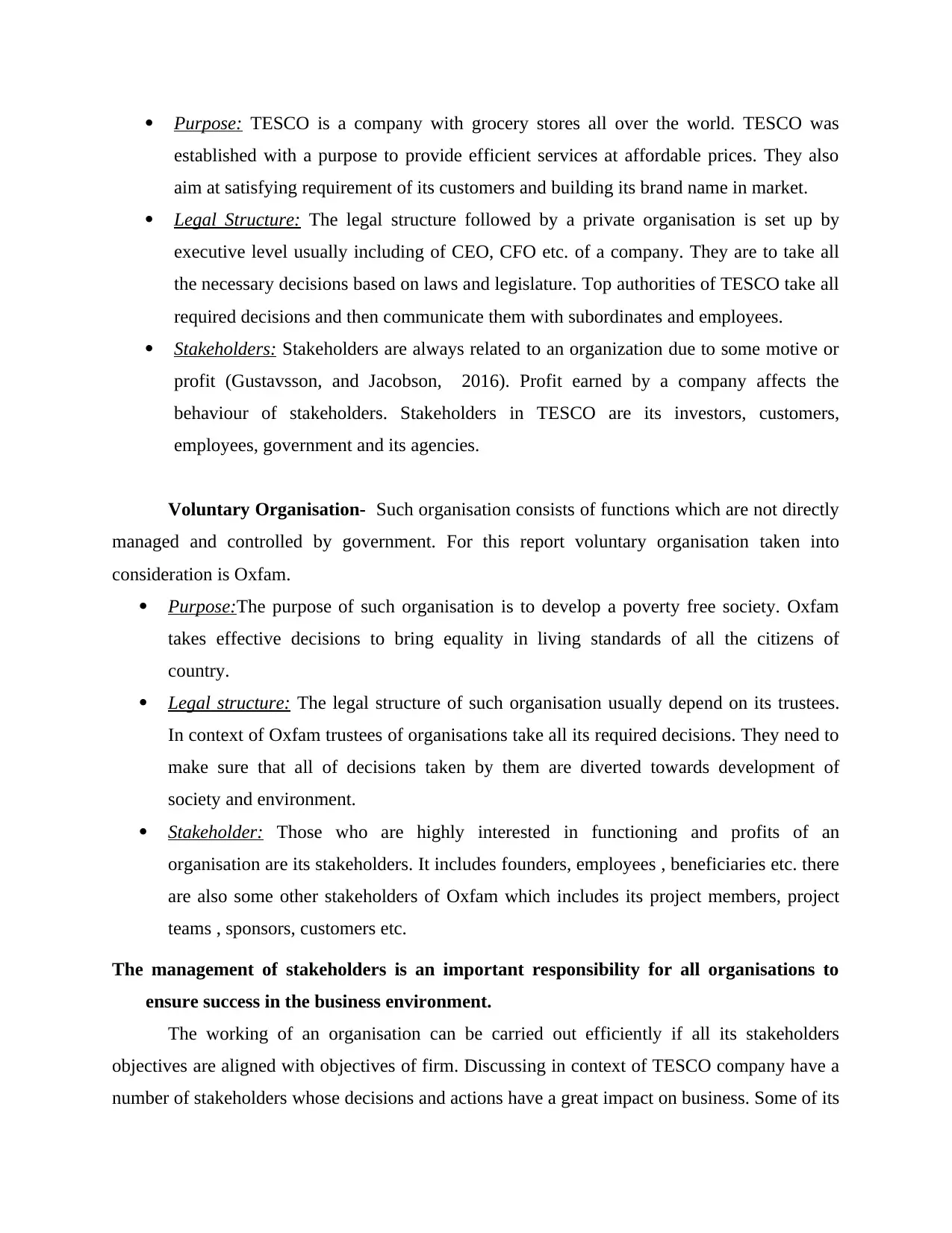
Purpose: TESCO is a company with grocery stores all over the world. TESCO was
established with a purpose to provide efficient services at affordable prices. They also
aim at satisfying requirement of its customers and building its brand name in market.
Legal Structure: The legal structure followed by a private organisation is set up by
executive level usually including of CEO, CFO etc. of a company. They are to take all
the necessary decisions based on laws and legislature. Top authorities of TESCO take all
required decisions and then communicate them with subordinates and employees.
Stakeholders: Stakeholders are always related to an organization due to some motive or
profit (Gustavsson, and Jacobson, 2016). Profit earned by a company affects the
behaviour of stakeholders. Stakeholders in TESCO are its investors, customers,
employees, government and its agencies.
Voluntary Organisation- Such organisation consists of functions which are not directly
managed and controlled by government. For this report voluntary organisation taken into
consideration is Oxfam.
Purpose:The purpose of such organisation is to develop a poverty free society. Oxfam
takes effective decisions to bring equality in living standards of all the citizens of
country.
Legal structure: The legal structure of such organisation usually depend on its trustees.
In context of Oxfam trustees of organisations take all its required decisions. They need to
make sure that all of decisions taken by them are diverted towards development of
society and environment.
Stakeholder: Those who are highly interested in functioning and profits of an
organisation are its stakeholders. It includes founders, employees , beneficiaries etc. there
are also some other stakeholders of Oxfam which includes its project members, project
teams , sponsors, customers etc.
The management of stakeholders is an important responsibility for all organisations to
ensure success in the business environment.
The working of an organisation can be carried out efficiently if all its stakeholders
objectives are aligned with objectives of firm. Discussing in context of TESCO company have a
number of stakeholders whose decisions and actions have a great impact on business. Some of its
established with a purpose to provide efficient services at affordable prices. They also
aim at satisfying requirement of its customers and building its brand name in market.
Legal Structure: The legal structure followed by a private organisation is set up by
executive level usually including of CEO, CFO etc. of a company. They are to take all
the necessary decisions based on laws and legislature. Top authorities of TESCO take all
required decisions and then communicate them with subordinates and employees.
Stakeholders: Stakeholders are always related to an organization due to some motive or
profit (Gustavsson, and Jacobson, 2016). Profit earned by a company affects the
behaviour of stakeholders. Stakeholders in TESCO are its investors, customers,
employees, government and its agencies.
Voluntary Organisation- Such organisation consists of functions which are not directly
managed and controlled by government. For this report voluntary organisation taken into
consideration is Oxfam.
Purpose:The purpose of such organisation is to develop a poverty free society. Oxfam
takes effective decisions to bring equality in living standards of all the citizens of
country.
Legal structure: The legal structure of such organisation usually depend on its trustees.
In context of Oxfam trustees of organisations take all its required decisions. They need to
make sure that all of decisions taken by them are diverted towards development of
society and environment.
Stakeholder: Those who are highly interested in functioning and profits of an
organisation are its stakeholders. It includes founders, employees , beneficiaries etc. there
are also some other stakeholders of Oxfam which includes its project members, project
teams , sponsors, customers etc.
The management of stakeholders is an important responsibility for all organisations to
ensure success in the business environment.
The working of an organisation can be carried out efficiently if all its stakeholders
objectives are aligned with objectives of firm. Discussing in context of TESCO company have a
number of stakeholders whose decisions and actions have a great impact on business. Some of its
Paraphrase This Document
Need a fresh take? Get an instant paraphrase of this document with our AI Paraphraser
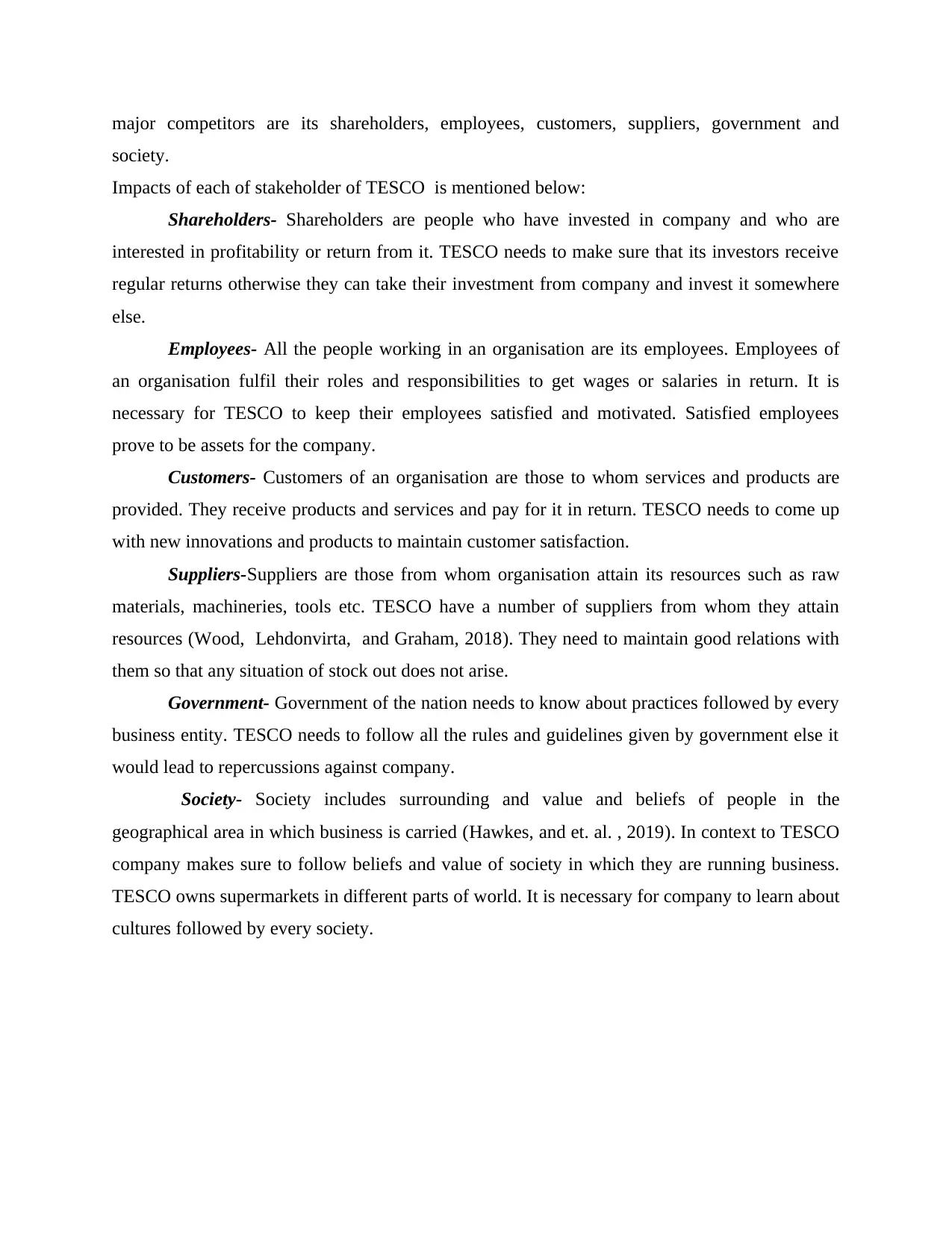
major competitors are its shareholders, employees, customers, suppliers, government and
society.
Impacts of each of stakeholder of TESCO is mentioned below:
Shareholders- Shareholders are people who have invested in company and who are
interested in profitability or return from it. TESCO needs to make sure that its investors receive
regular returns otherwise they can take their investment from company and invest it somewhere
else.
Employees- All the people working in an organisation are its employees. Employees of
an organisation fulfil their roles and responsibilities to get wages or salaries in return. It is
necessary for TESCO to keep their employees satisfied and motivated. Satisfied employees
prove to be assets for the company.
Customers- Customers of an organisation are those to whom services and products are
provided. They receive products and services and pay for it in return. TESCO needs to come up
with new innovations and products to maintain customer satisfaction.
Suppliers-Suppliers are those from whom organisation attain its resources such as raw
materials, machineries, tools etc. TESCO have a number of suppliers from whom they attain
resources (Wood, Lehdonvirta, and Graham, 2018). They need to maintain good relations with
them so that any situation of stock out does not arise.
Government- Government of the nation needs to know about practices followed by every
business entity. TESCO needs to follow all the rules and guidelines given by government else it
would lead to repercussions against company.
Society- Society includes surrounding and value and beliefs of people in the
geographical area in which business is carried (Hawkes, and et. al. , 2019). In context to TESCO
company makes sure to follow beliefs and value of society in which they are running business.
TESCO owns supermarkets in different parts of world. It is necessary for company to learn about
cultures followed by every society.
society.
Impacts of each of stakeholder of TESCO is mentioned below:
Shareholders- Shareholders are people who have invested in company and who are
interested in profitability or return from it. TESCO needs to make sure that its investors receive
regular returns otherwise they can take their investment from company and invest it somewhere
else.
Employees- All the people working in an organisation are its employees. Employees of
an organisation fulfil their roles and responsibilities to get wages or salaries in return. It is
necessary for TESCO to keep their employees satisfied and motivated. Satisfied employees
prove to be assets for the company.
Customers- Customers of an organisation are those to whom services and products are
provided. They receive products and services and pay for it in return. TESCO needs to come up
with new innovations and products to maintain customer satisfaction.
Suppliers-Suppliers are those from whom organisation attain its resources such as raw
materials, machineries, tools etc. TESCO have a number of suppliers from whom they attain
resources (Wood, Lehdonvirta, and Graham, 2018). They need to maintain good relations with
them so that any situation of stock out does not arise.
Government- Government of the nation needs to know about practices followed by every
business entity. TESCO needs to follow all the rules and guidelines given by government else it
would lead to repercussions against company.
Society- Society includes surrounding and value and beliefs of people in the
geographical area in which business is carried (Hawkes, and et. al. , 2019). In context to TESCO
company makes sure to follow beliefs and value of society in which they are running business.
TESCO owns supermarkets in different parts of world. It is necessary for company to learn about
cultures followed by every society.
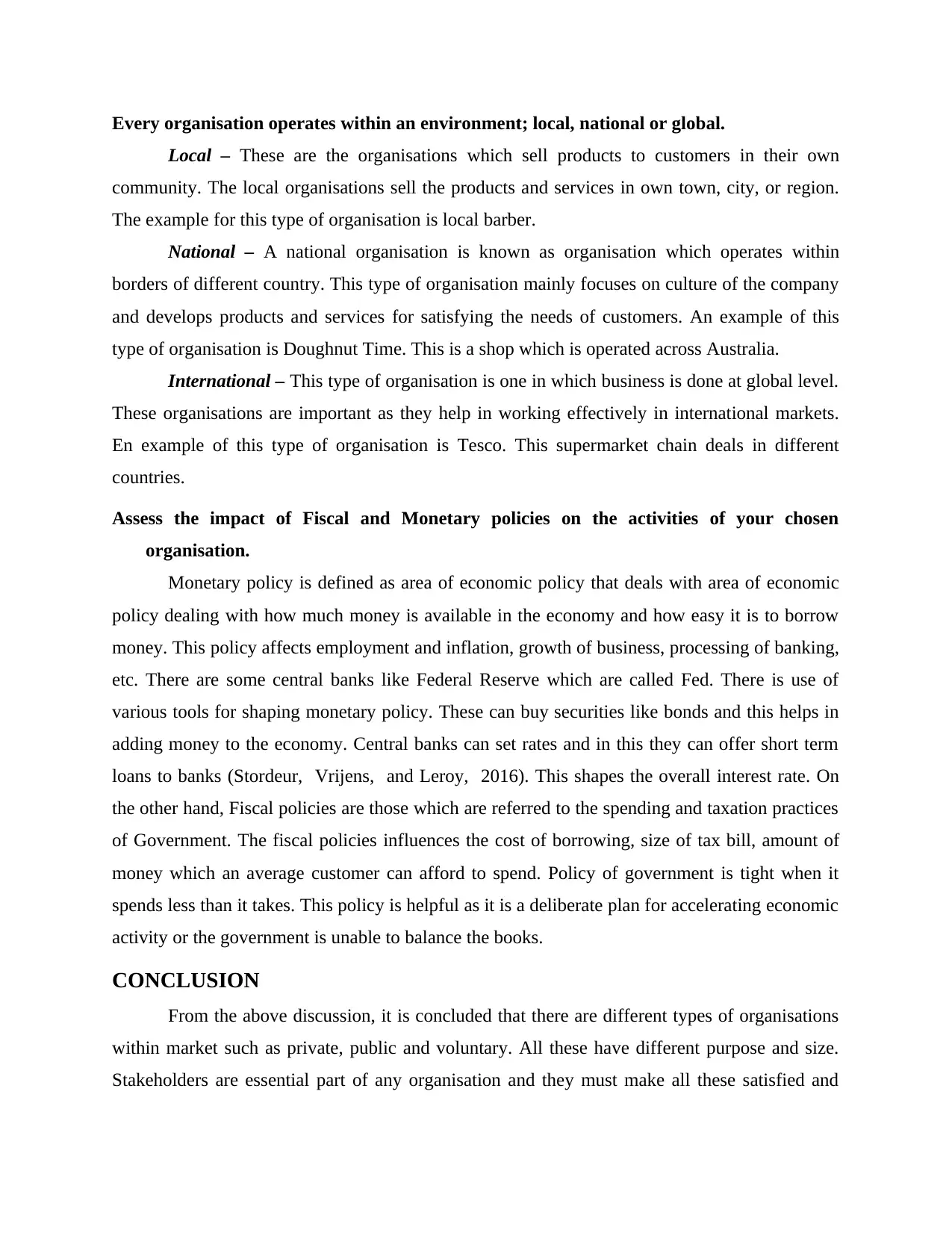
Every organisation operates within an environment; local, national or global.
Local – These are the organisations which sell products to customers in their own
community. The local organisations sell the products and services in own town, city, or region.
The example for this type of organisation is local barber.
National – A national organisation is known as organisation which operates within
borders of different country. This type of organisation mainly focuses on culture of the company
and develops products and services for satisfying the needs of customers. An example of this
type of organisation is Doughnut Time. This is a shop which is operated across Australia.
International – This type of organisation is one in which business is done at global level.
These organisations are important as they help in working effectively in international markets.
En example of this type of organisation is Tesco. This supermarket chain deals in different
countries.
Assess the impact of Fiscal and Monetary policies on the activities of your chosen
organisation.
Monetary policy is defined as area of economic policy that deals with area of economic
policy dealing with how much money is available in the economy and how easy it is to borrow
money. This policy affects employment and inflation, growth of business, processing of banking,
etc. There are some central banks like Federal Reserve which are called Fed. There is use of
various tools for shaping monetary policy. These can buy securities like bonds and this helps in
adding money to the economy. Central banks can set rates and in this they can offer short term
loans to banks (Stordeur, Vrijens, and Leroy, 2016). This shapes the overall interest rate. On
the other hand, Fiscal policies are those which are referred to the spending and taxation practices
of Government. The fiscal policies influences the cost of borrowing, size of tax bill, amount of
money which an average customer can afford to spend. Policy of government is tight when it
spends less than it takes. This policy is helpful as it is a deliberate plan for accelerating economic
activity or the government is unable to balance the books.
CONCLUSION
From the above discussion, it is concluded that there are different types of organisations
within market such as private, public and voluntary. All these have different purpose and size.
Stakeholders are essential part of any organisation and they must make all these satisfied and
Local – These are the organisations which sell products to customers in their own
community. The local organisations sell the products and services in own town, city, or region.
The example for this type of organisation is local barber.
National – A national organisation is known as organisation which operates within
borders of different country. This type of organisation mainly focuses on culture of the company
and develops products and services for satisfying the needs of customers. An example of this
type of organisation is Doughnut Time. This is a shop which is operated across Australia.
International – This type of organisation is one in which business is done at global level.
These organisations are important as they help in working effectively in international markets.
En example of this type of organisation is Tesco. This supermarket chain deals in different
countries.
Assess the impact of Fiscal and Monetary policies on the activities of your chosen
organisation.
Monetary policy is defined as area of economic policy that deals with area of economic
policy dealing with how much money is available in the economy and how easy it is to borrow
money. This policy affects employment and inflation, growth of business, processing of banking,
etc. There are some central banks like Federal Reserve which are called Fed. There is use of
various tools for shaping monetary policy. These can buy securities like bonds and this helps in
adding money to the economy. Central banks can set rates and in this they can offer short term
loans to banks (Stordeur, Vrijens, and Leroy, 2016). This shapes the overall interest rate. On
the other hand, Fiscal policies are those which are referred to the spending and taxation practices
of Government. The fiscal policies influences the cost of borrowing, size of tax bill, amount of
money which an average customer can afford to spend. Policy of government is tight when it
spends less than it takes. This policy is helpful as it is a deliberate plan for accelerating economic
activity or the government is unable to balance the books.
CONCLUSION
From the above discussion, it is concluded that there are different types of organisations
within market such as private, public and voluntary. All these have different purpose and size.
Stakeholders are essential part of any organisation and they must make all these satisfied and
⊘ This is a preview!⊘
Do you want full access?
Subscribe today to unlock all pages.

Trusted by 1+ million students worldwide
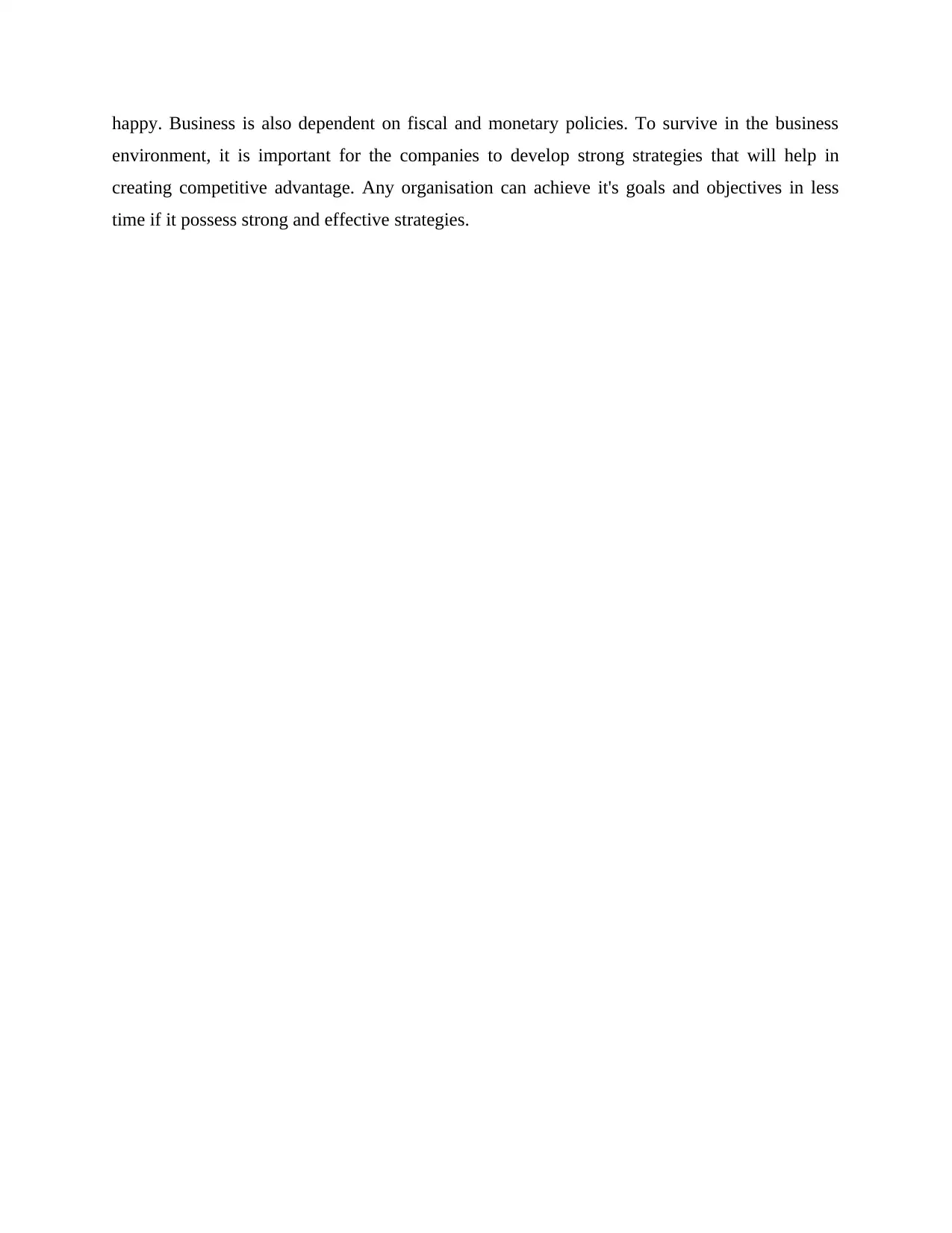
happy. Business is also dependent on fiscal and monetary policies. To survive in the business
environment, it is important for the companies to develop strong strategies that will help in
creating competitive advantage. Any organisation can achieve it's goals and objectives in less
time if it possess strong and effective strategies.
environment, it is important for the companies to develop strong strategies that will help in
creating competitive advantage. Any organisation can achieve it's goals and objectives in less
time if it possess strong and effective strategies.
Paraphrase This Document
Need a fresh take? Get an instant paraphrase of this document with our AI Paraphraser
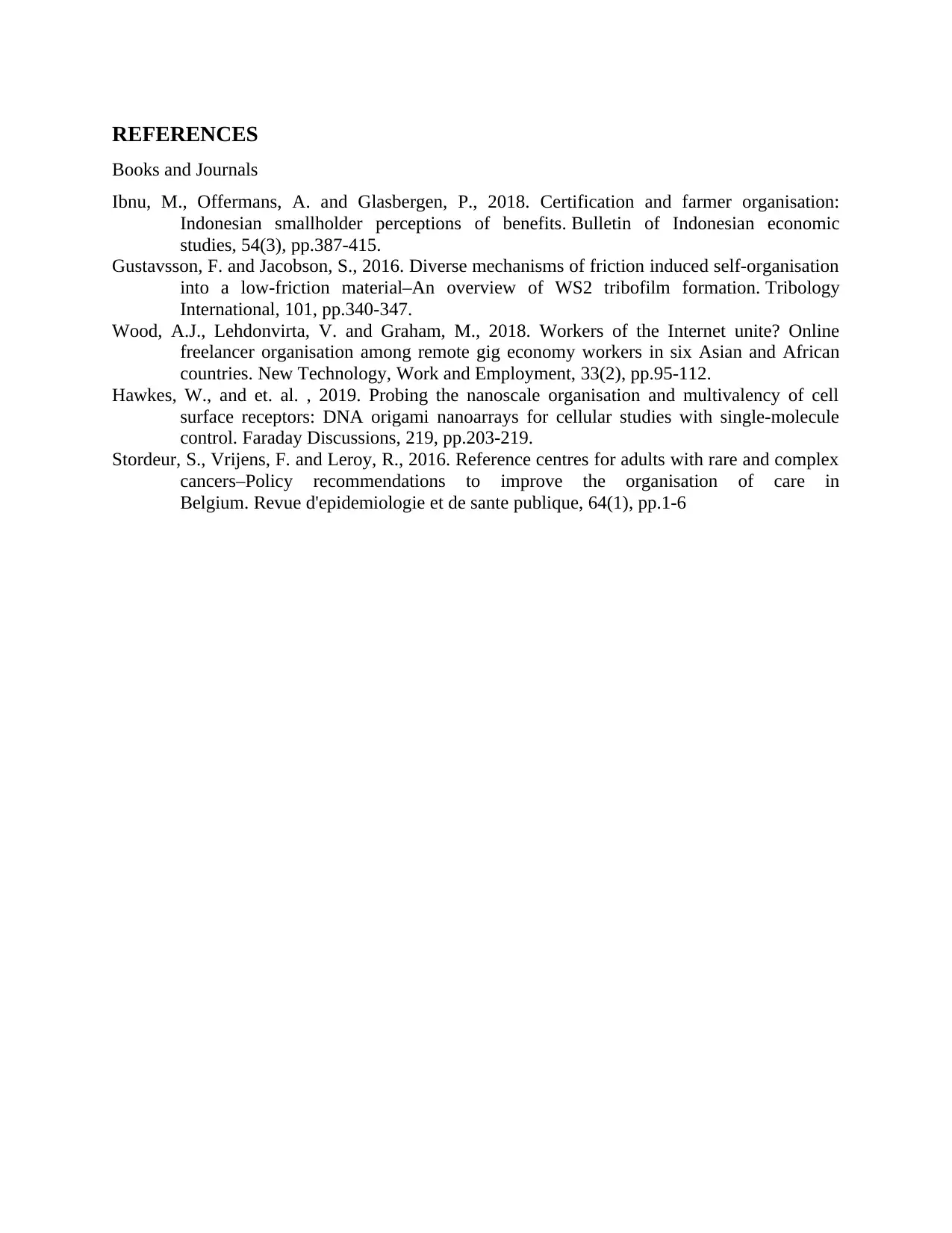
REFERENCES
Books and Journals
Ibnu, M., Offermans, A. and Glasbergen, P., 2018. Certification and farmer organisation:
Indonesian smallholder perceptions of benefits. Bulletin of Indonesian economic
studies, 54(3), pp.387-415.
Gustavsson, F. and Jacobson, S., 2016. Diverse mechanisms of friction induced self-organisation
into a low-friction material–An overview of WS2 tribofilm formation. Tribology
International, 101, pp.340-347.
Wood, A.J., Lehdonvirta, V. and Graham, M., 2018. Workers of the Internet unite? Online
freelancer organisation among remote gig economy workers in six Asian and African
countries. New Technology, Work and Employment, 33(2), pp.95-112.
Hawkes, W., and et. al. , 2019. Probing the nanoscale organisation and multivalency of cell
surface receptors: DNA origami nanoarrays for cellular studies with single-molecule
control. Faraday Discussions, 219, pp.203-219.
Stordeur, S., Vrijens, F. and Leroy, R., 2016. Reference centres for adults with rare and complex
cancers–Policy recommendations to improve the organisation of care in
Belgium. Revue d'epidemiologie et de sante publique, 64(1), pp.1-6
Books and Journals
Ibnu, M., Offermans, A. and Glasbergen, P., 2018. Certification and farmer organisation:
Indonesian smallholder perceptions of benefits. Bulletin of Indonesian economic
studies, 54(3), pp.387-415.
Gustavsson, F. and Jacobson, S., 2016. Diverse mechanisms of friction induced self-organisation
into a low-friction material–An overview of WS2 tribofilm formation. Tribology
International, 101, pp.340-347.
Wood, A.J., Lehdonvirta, V. and Graham, M., 2018. Workers of the Internet unite? Online
freelancer organisation among remote gig economy workers in six Asian and African
countries. New Technology, Work and Employment, 33(2), pp.95-112.
Hawkes, W., and et. al. , 2019. Probing the nanoscale organisation and multivalency of cell
surface receptors: DNA origami nanoarrays for cellular studies with single-molecule
control. Faraday Discussions, 219, pp.203-219.
Stordeur, S., Vrijens, F. and Leroy, R., 2016. Reference centres for adults with rare and complex
cancers–Policy recommendations to improve the organisation of care in
Belgium. Revue d'epidemiologie et de sante publique, 64(1), pp.1-6
1 out of 8
Related Documents
Your All-in-One AI-Powered Toolkit for Academic Success.
+13062052269
info@desklib.com
Available 24*7 on WhatsApp / Email
![[object Object]](/_next/static/media/star-bottom.7253800d.svg)
Unlock your academic potential
Copyright © 2020–2025 A2Z Services. All Rights Reserved. Developed and managed by ZUCOL.





